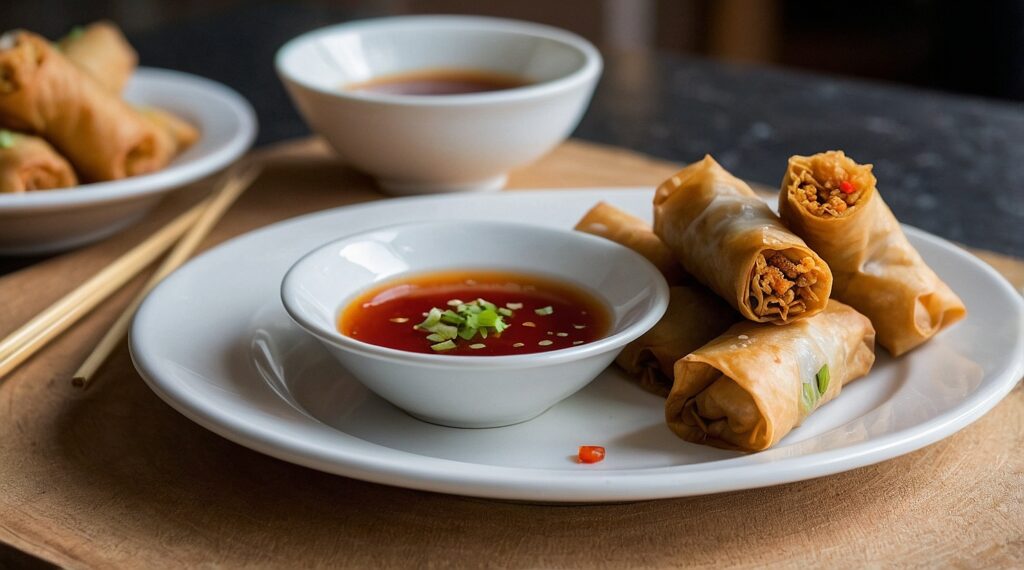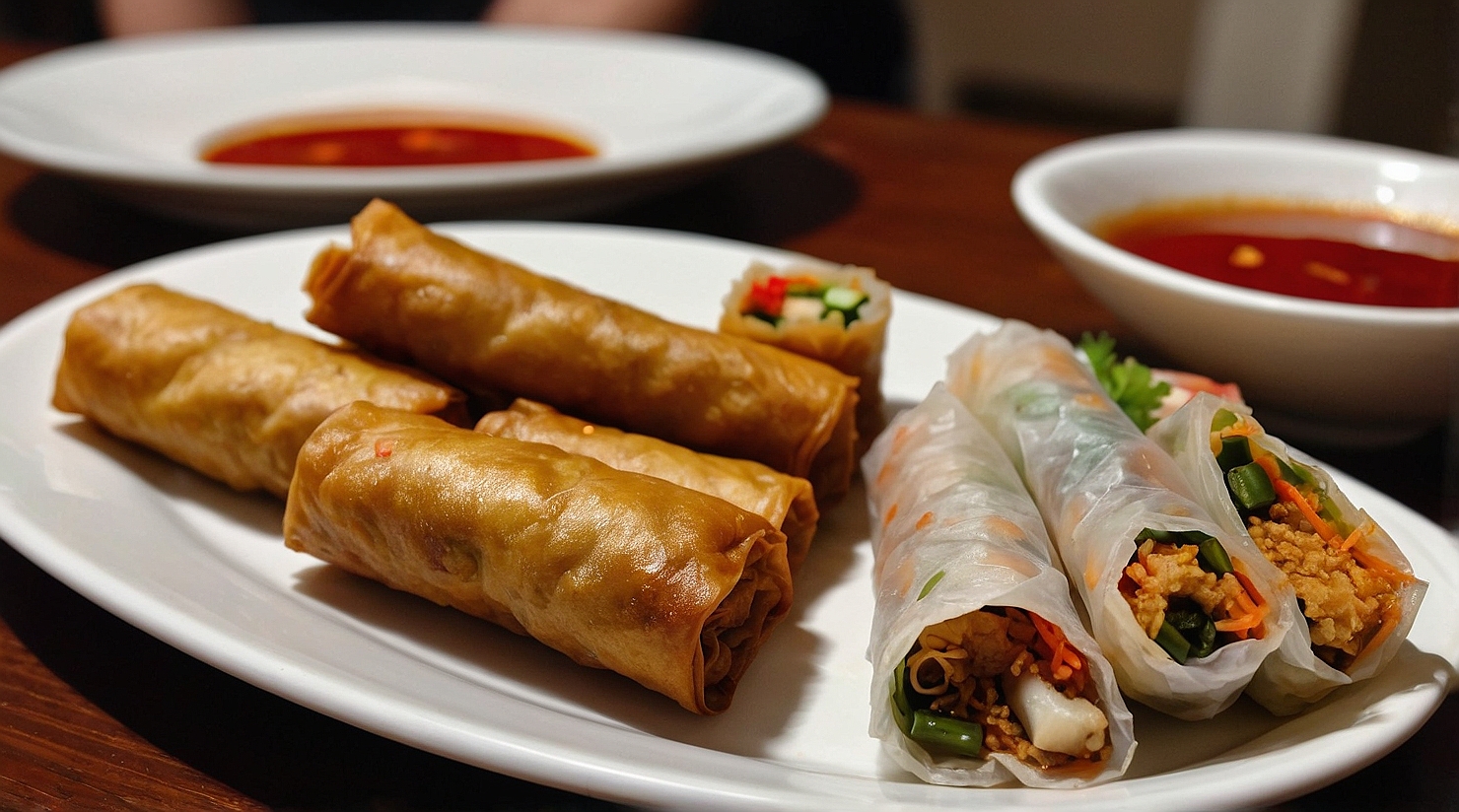What are Spring Rolls?
Spring rolls are one of the most beloved appetizers across various Asian cuisines. Originating from China, these rolls have been adopted by different cultures, including Vietnam and Thailand, each adding their unique twist. Spring rolls are traditionally served as a celebratory dish during the Spring Festival in China, marking the arrival of spring, which is how they got their name.
Spring rolls are typically made by wrapping a mixture of vegetables, sometimes combined with meat or seafood, in a thin pastry-like wrapper. The versatility of the filling is one of the reasons why spring rolls have become so popular. The wrappers used for spring rolls are often made from wheat flour, giving them a crisp, golden texture once fried.
For more detailed information on the common ingredients used in spring rolls, check out this post about what ingredients are in a summer roll. Even though this focuses on summer rolls, the key differences in ingredients can help further understand the nuances.
Different Types of Spring Rolls
Spring rolls come in various forms, each influenced by the region they hail from. Here are some of the most popular types:
- Chinese Spring Rolls: These are perhaps the most famous, known for their crispy golden exterior. They are typically filled with vegetables, minced pork, or shrimp.
- Vietnamese Cha Gio: Also known as fried spring rolls, these are usually smaller than Chinese versions and are filled with ground pork, shrimp, vermicelli noodles, and mushrooms.
- Thai Spring Rolls: In Thailand, spring rolls are filled with fresh herbs, glass noodles, and a mixture of vegetables. These can be deep-fried or served fresh with sweet chili dipping sauce.
If you’re curious to explore more variations, especially shrimp summer rolls, you can check out this comprehensive guide on shrimp summer rolls.
Ingredients in Spring Rolls
While the filling of spring rolls can vary based on location and preference, there are some common ingredients used across all variations. Below is a list of ingredients that are commonly found in spring rolls:
- Vegetables: Cabbage, carrots, bean sprouts, and scallions are staples.
- Proteins: Pork, shrimp, or chicken are the most common meat fillings. Tofu is a popular vegetarian option.
- Noodles: Thin vermicelli noodles are often included in the filling.
- Seasonings: Soy sauce, oyster sauce, and hoisin sauce are frequently used to season the fillings.
Spring rolls are typically wrapped in thin wheat-based wrappers. However, the fillings and flavors can be adjusted to accommodate different tastes, diets, and regional preferences.
How Spring Rolls Are Cooked
Spring rolls are usually prepared by deep-frying them, resulting in a crispy exterior and savory, warm filling inside. The wrappers used for spring rolls are designed to withstand frying and create that iconic crunchy texture that is hard to resist. The fried method is most commonly associated with Chinese and Vietnamese spring rolls, although there are some variations, such as non-fried or baked spring rolls, which offer a healthier alternative.
Here’s a look at the two main cooking methods:
- Fried Spring Rolls: The most common preparation involves frying the rolls in hot oil until they turn golden brown. The fried wrapper is light, crispy, and flaky.
- Baked Spring Rolls: A less common method, baking the spring rolls involves placing them in the oven instead of deep-frying. This method uses less oil and is considered healthier, though it results in a slightly different texture.
What are Summer Rolls?
Summer rolls, also known as Vietnamese goi cuon, are a fresh and healthy alternative to the fried spring roll. Unlike spring rolls, summer rolls are served fresh, without frying. Originating in Vietnam, summer rolls have become a favorite for those seeking a lighter and more refreshing appetizer.
Summer rolls are made using translucent rice paper wrappers, which are softer and chewier than wheat wrappers used in spring rolls. Inside, they are filled with a combination of fresh vegetables, herbs, and lean proteins such as shrimp, pork, or tofu.
For more ideas and ingredient inspiration for making these at home, this shrimp summer rolls guide offers additional information on how to craft delicious and fresh rolls.
Ingredients in Summer Rolls
Summer rolls rely on fresh, raw ingredients to create their light and refreshing taste. Below is a list of the typical ingredients found in summer rolls:
- Fresh Herbs: Mint, cilantro, and Thai basil are commonly used to add a burst of flavor.
- Vegetables: Lettuce, cucumber, carrots, and bean sprouts provide a crunchy texture.
- Protein: Shrimp, pork, or tofu are the primary protein sources in summer rolls.
- Noodles: Thin vermicelli noodles are often added for texture.
- Rice Paper Wrappers: These delicate, translucent wrappers hold the fillings together and are soft to the touch after soaking in warm water.
How Summer Rolls Are Prepared
Summer rolls are incredibly easy to make and don’t require any frying. This not only makes them a healthier option but also preserves the freshness of the ingredients inside.
Here is a simple breakdown of how summer rolls are prepared:
- Soak Rice Paper Wrappers: The rice paper wrappers are briefly soaked in warm water until they become soft and pliable.
- Prepare the Filling: Fresh vegetables, herbs, noodles, and protein (such as shrimp or tofu) are gathered and prepped.
- Roll the Summer Rolls: Once the ingredients are prepared, they are placed in the center of the softened rice paper, which is then rolled tightly around the fillings.
Health Benefits of Summer Rolls
Since summer rolls are not fried, they are considered a healthier option compared to spring rolls. They contain fresh vegetables, herbs, and lean proteins, making them a low-calorie snack or appetizer.
Some health benefits of summer rolls include:
- Low in Calories: Without the added oil from frying, summer rolls are much lower in calories.
- Rich in Nutrients: The fresh vegetables and herbs provide vitamins, minerals, and antioxidants.
- Good Source of Protein: The addition of shrimp, pork, or tofu makes summer rolls a well-balanced snack.
Key Differences Between Spring Rolls and Summer Rolls
The differences between spring rolls and summer rolls go beyond just how they are prepared. The key differences lie in the ingredients, cooking method, and texture.
| Feature | Spring Rolls | Summer Rolls |
| Wrapping Material | Thin wheat wrappers | Rice paper wrappers |
| Cooking Method | Fried (mostly) | Fresh, no frying |
| Filling Ingredients | Cooked vegetables and meat | Fresh vegetables, herbs, shrimp/pork |
| Texture | Crispy, crunchy | Soft, chewy |
| Serving Temperature | Hot | Cold or room temperature |
Which is Healthier: Spring Rolls or Summer Rolls?
When comparing spring rolls vs. summer rolls in terms of health, summer rolls generally come out on top. Since spring rolls are fried, they are higher in calories and fat, while summer rolls are fresh and light.
Here’s a comparison of their nutritional content:
| Nutrient | Fried Spring Roll (1 roll) | Summer Roll (1 roll) |
| Calories | 130-150 | 60-80 |
| Fat | 6-8g | 1-2g |
| Protein | 3-4g | 4-5g |
How to Make Spring Rolls at Home
Making spring rolls at home can be a fun and rewarding activity. Here’s a step-by-step guide:
Recipe for Crispy Spring Rolls
Ingredients:
- 10 spring roll wrappers (wheat-based)
- 1 cup shredded cabbage
- 1/2 cup grated carrots
- 100g minced pork or shrimp
- 1/4 cup glass noodles
- 2 tbsp soy sauce
- 1 tbsp oyster sauce
Instructions:
- Prepare the filling: Stir-fry the minced pork or shrimp with soy sauce and oyster sauce until cooked. Add cabbage, carrots, and noodles.
- Wrap the rolls: Place the filling in the center of the wrapper, fold in the edges, and roll tightly.
- Fry the rolls: Heat oil in a pan and fry the rolls until golden brown and crispy.
- Serve: Serve with sweet chili sauce or soy sauce.

How to Make Summer Rolls at Home
Recipe for Fresh Summer Rolls
Ingredients:
- 10 rice paper wrappers
- 1 cup shredded lettuce
- 1/2 cup fresh mint leaves
- 100g cooked shrimp
- 1/4 cup rice vermicelli noodles
- Peanut dipping sauce
Instructions:
- Soak the rice paper: Soak each wrapper in warm water until soft.
- Prepare the filling: Place lettuce, mint, shrimp, and noodles on the softened rice paper.
- Roll the summer rolls: Roll tightly, folding in the sides as you go.
- Serve: Serve with a peanut dipping sauce.
FAQs About Spring Rolls and Summer Rolls
Can Spring Rolls Be Eaten Fresh Like Summer Rolls?
Yes, some spring rolls are served fresh, but most are fried for a crispy texture. Summer rolls are always fresh, not fried.
What Dipping Sauces Go Best with Spring Rolls and Summer Rolls?
- Spring rolls: Sweet chili sauce, soy sauce, or hoisin sauce.
- Summer rolls: Peanut dipping sauce or hoisin sauce.
Can You Use the Same Wrappers for Spring Rolls and Summer Rolls?
No. Spring rolls typically use wheat wrappers, while summer rolls use rice paper wrappers.
Are Spring Rolls and Summer Rolls Gluten-Free?
Spring rolls are usually not gluten-free, but summer rolls can be gluten-free if you use gluten-free rice paper and soy sauce alternatives.
Conclusion: Spring Rolls vs. Summer Rolls – Which One to Choose?
Whether you choose spring rolls or summer rolls depends on your personal preference and dietary goals. If you’re craving something crispy and indulgent, spring rolls are the perfect choice. But if you’re looking for something light and fresh, summer rolls are a healthier option. Both types of rolls offer delicious flavors and can be easily made at home. Try them both and see which one you prefer!

